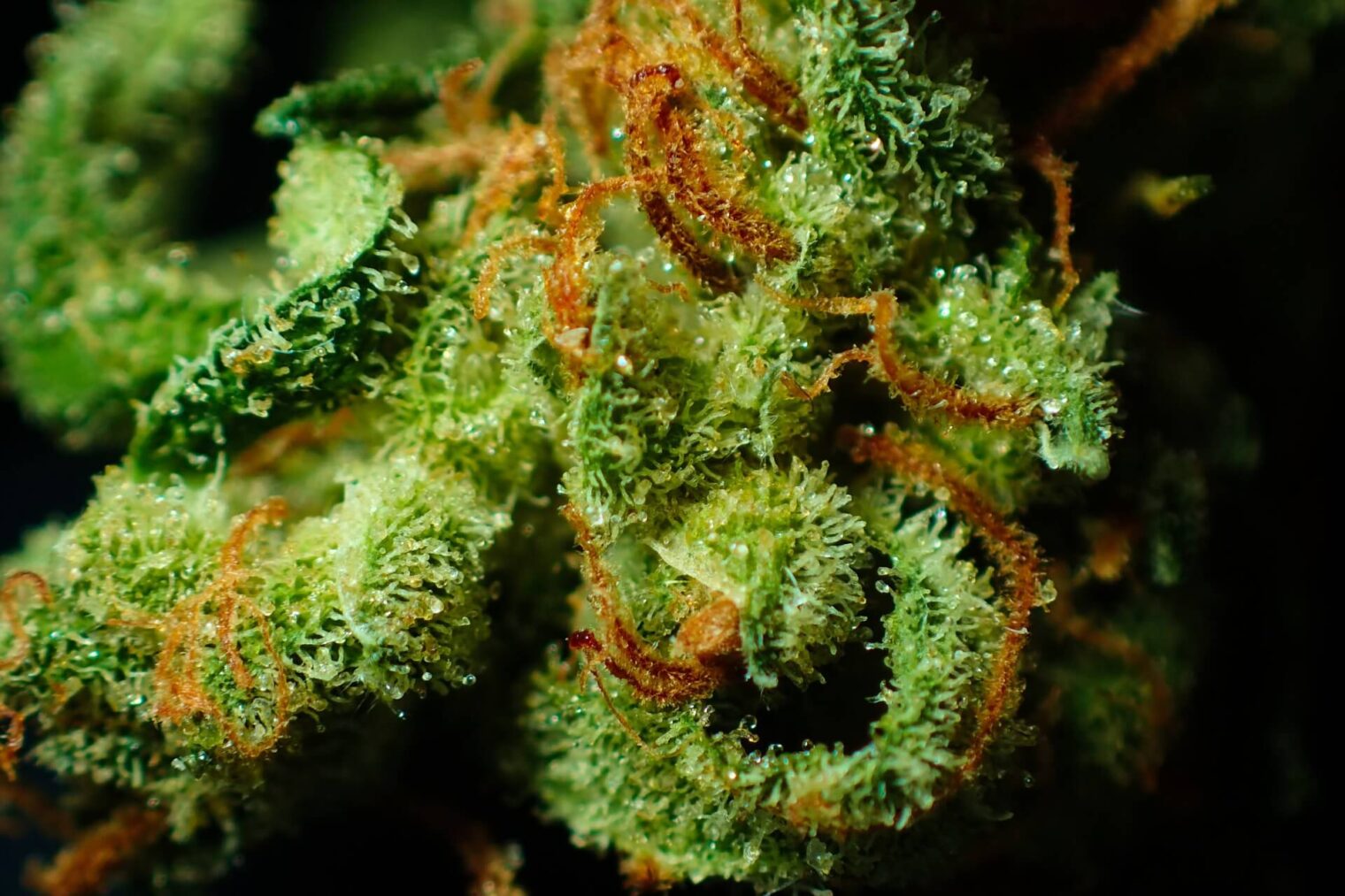Table of Contents

Cannabis terpenes are becoming an interesting subject for marijuana experts. Have you ever wondered why different kinds of cannabis affect you in unique ways? It’s not just about THC or CBD levels. There’s another player in town: terpenes. Terpenes are what give plants their aroma and flavor, and they’re not limited to cannabis.
They can be found in everything from the lavender used to calm your nerves to the citrus in your cleaning products.
One interesting fact is that there are over 100 different terpenes identified in cannabis plants alone, each contributing its own set of effects and benefits. This article will guide you through the fascinating world of weed terpenes, exploring their medical advantages, how they enhance your experience with marijuana, and why knowing more about them can completely change how you view this versatile plant.
Ready for a deeper understanding? Keep reading!
Understanding Terpenes: What are They and Where Do They Come From?
Terpenes are organic compounds found in a variety of plants, contributing to their aroma and flavor profiles. They originate from the same glands that produce cannabinoids in cannabis, such as the resinous trichomes.
Definition of terpenes
Terpenes are aromatic compounds found in many plants, including cannabis products. They give plants their unique scents and play a crucial role in protecting them from pests and environmental stresses.
In the cannabis plant, these compounds are responsible for the distinctive aromas and flavors that vary from one strain to another. Beyond adding sensory attributes, terpenes also interact with cannabinoids such as THC and CBD, influencing the effects of cannabis on the body.
Sources of terpenes extend beyond just cannabis. They exist in herbs, fruits, and even some insects use them defensively. This versatility makes terpenes a significant topic of interest across different fields including aromatherapy, herbal medicine, and the burgeoning cannabis industry.
Sources of terpenes
Plants, including cannabis, are the primary sources of terpenes. These organic compounds are produced in various parts of the plant, such as the flowers, leaves, and stems. Terpenes can also be found in other botanicals like fruits, herbs, and spices.
They contribute to the characteristic aroma and flavor profiles of different plant species. In cannabis plants specifically, terpenes are responsible for producing scents ranging from citrusy to earthy or floral notes.
A deeper look into how these diverse aromas originate from different sources unveils the secrets behind each strain’s unique scent profile. Understanding where terpenes come from offers valuable insight into their potential effects when used alongside cannabinoids.
Medicinal Benefits of Terpenes
Terpenes offer a range of medicinal benefits, including their antiviral, anticancer, antidepressant, antimicrobial, and pain relief properties. These properties contribute to the therapeutic effects of cannabis and are increasingly being recognized for their potential in medical treatments.
Antiviral properties
Scientists have discovered that weed terpenes possess antiviral properties, which can help to combat viral infections within the body. These terpenes can bolster the immune system and inhibit the replication of certain viruses, offering a natural defense against viral illnesses.
This is particularly promising in light of increasing antibiotic resistance and the need for alternative antiviral treatments.
Additionally, these antiviral properties align with ongoing research into developing new pharmaceuticals that harness the potential of weed terpenes to create effective antiviral medications.
Anticancer properties
Transitioning from the topic of antiviral properties, we move into understanding the anticancer properties of terpenes. While cannabinoids are typically credited with cannabis’s potential to combat cancer, terpenes also play a vital role.
Research indicates that certain terpenes exhibit anticancer effects, potentially inhibiting tumor growth and inducing cancer cell death. This underscores the vast potential for utilizing terpenes in complementary therapies targeting various types of cancer.
Terpene profile and effects chart
Antidepressant properties
Marijuana terpenes have been found to exhibit antidepressant properties, potentially playing a role in mood regulation and mental wellness. The interaction of specific terpenes with neurotransmitters may contribute to their antidepressant effects.
For instance, certain terpenes like limonene and beta-caryophyllene have shown promise in alleviating symptoms of depression by modulating serotonin and dopamine levels in the brain.
This suggests that cannabis strains containing these terpenes could be beneficial for individuals seeking natural alternatives for managing mood-related conditions.
Antimicrobial properties
Terpenes possess antimicrobial properties due to their ability to inhibit the growth of microorganisms, including bacteria and fungi. These natural compounds can help in fighting off harmful pathogens and promoting health.
Research has shown that certain terpenes, such as limonene and pinene, exhibit strong antimicrobial effects, making them valuable for medicinal and therapeutic purposes. Their potential in combating infectious agents makes them a significant area of interest in the medical and pharmaceutical fields.
The antimicrobial benefits of terpenes extend beyond just their aromatic characteristics. As natural defense mechanisms produced by plants, these compounds have been found to offer promising prospects for addressing microbial infections while contributing to the overall therapeutic potential of cannabis products.
Pain relief properties
Transitioning from the antimicrobial properties of terpenes to their pain relief properties, it’s essential to recognize that many terpenes hold potential for alleviating pain. Linalool, a common terpene found in cannabis, exhibits analgesic and anti-inflammatory effects.
Limonene, another prevalent terpene, has been identified as aiding in the reduction of discomfort and inflammation. Beta-caryophyllene is also known for its ability to alleviate pain by acting on the body’s endocannabinoid system.
These findings highlight the diverse range of terpenes’ potential in providing relief from various types of pain.
The medicinal benefits associated with certain weed-derived terpenes extend beyond their aromatic characteristics and flavor profiles to include properties that could potentially provide natural pain relief solutions.
How Terpenes Contribute to the Effects of Cannabis
Terpenes interact with cannabinoids, enhancing or modifying the effects of cannabis. Various terpenes found in cannabis can influence mood, stress levels, and pain perception. Some common terpenes include myrcene, limonene, and pinene.
Interaction with cannabinoids
Cannabinoids such as THC and CBD can be significantly influenced by the presence of terpenes in cannabis. Terpenes work synergistically with cannabinoids, enhancing or moderating their effects based on the specific combination present.
For instance, myrcene, a common terpene found in cannabis, may contribute to the sedative effects often associated with indica strains. On the other hand, limonene has been observed to potentially elevate mood and relieve stress when combined with cannabinoids like CBD.
This interaction underscores the complexity of cannabis’s therapeutic potential.
Top terpenes found in cannabis
Transitioning from “Interaction with cannabinoids” to “Top terpenes found in cannabis,” we delve into the aromatic compounds that give cannabis its unique scent and flavor. These terpenes not only contribute to the sensory experience of consuming cannabis but also play a crucial role in enhancing its therapeutic effects.
Some of the top terpenes found in cannabis include myrcene, limonene, pinene, linalool, and caryophyllene. Each of these terpenes possesses distinct aroma characteristics and is known for its potential health benefits such as anti-inflammatory, sedative, or energizing properties.
Myrcene is recognized for its earthy and musky aroma and may contribute to the relaxing effects often associated with indica strains. Limonene offers a citrusy scent and is believed to promote an uplifted mood while potentially aiding in stress relief.
Pinene exhibits a fresh pine fragrance and has been linked to improved focus and respiratory support. Linalool contributes a floral aroma and is associated with calming effects that can alleviate anxiety.
The Latest in Cannabis 101: Everything You Need to Know About Terpenes
Unveil the secrets of terpenes in cannabis with a comprehensive guide to their aromas, flavors, and effects. Dive into the world of terpenes and cannabinoids to explore their combined therapeutic potential.
Terpenes vs. cannabinoids
Terpenes and cannabinoids are both compounds found in cannabis, each with distinct roles. Terpenes contribute to the aroma and flavor of cannabis, while cannabinoids like THC and CBD are responsible for delivering the medicinal effects.
Terpenes can also modulate the effects of cannabinoids, influencing factors such as mood, energy levels, or sedation. Understanding these interactions is crucial when seeking specific therapeutic benefits from cannabis.
Terpenes vs. cannabinoids – a comparison that sheds light on how different elements contribute to the overall properties of cannabis.
Influence on medical cannabis
Cannabis terpenes play a crucial role in influencing the medicinal benefits of medical cannabis. These aromatic compounds not only contribute to the aroma and flavor of different cannabis strains but also interact with cannabinoids, resulting in distinctive therapeutic effects.
By understanding the specific terpenes present in different varieties of medical cannabis, individuals can tailor their usage to target symptoms more effectively and experience enhanced relief.
Moving on to exploring common terpenes found in medical cannabis and how they influence its medicinal properties is essential for maximizing its potential as a natural remedy.
Common terpenes found in cannabis
Terpenes found in weed play a significant role in shaping the aroma and flavor of different strains. Some common terpenes include myrcene, which contributes to the earthy and musky scent often associated with cannabis.
Limonene is another prevalent terpene known for its citrusy aroma and potential mood-boosting effects. Additionally, pinene, with its pine-like fragrance, may offer anti-inflammatory properties.
Furthermore, linalool adds a floral scent while potentially providing calming effects. Finally, caryophyllene features a spicy aroma and could possess pain-relieving qualities.
Cannabis Terpenes I 2024
Unlocking the secrets of cannabis terpenes has unveiled their diverse effects, including antiviral, anticancer, antidepressant, antimicrobial, and pain relief properties. The practicality and efficiency of understanding the aromatic characteristics of terpenes can lead to significant improvements in utilizing medical cannabis.
By emphasizing the potential impact of applying these strategies, we have highlighted how terpenes play a crucial role in synergizing with THC and CBD for enhanced therapeutic benefits.
Exploring the diverse effects of common terpenes found in cannabis offers an opportunity for continued learning beyond this guide. Let the power of terpenes inspire you to embark on a journey towards unlocking their full potential.








